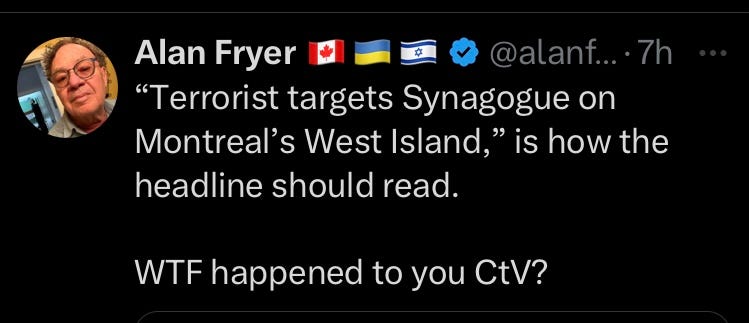Broadcasters’ hopes for salvation through subsidies dashed as streamers score big legal victories
Plus! The latest twist in Rachel Gilmore's soap opera, bizarre headlines protecting perps, why hasn't a reporter tracked down Mark Carney and we're looking good as the 51st state for sports
It was a pretty sad Christmas for the nation’s poverty-stricken broadcast newsrooms.
Expectations, after all, were high 19 months ago when then-Heritage Minister Pablo Rodriguez and Vicky Eatrides, chair of the Canadian Radio-television and Telecommunications Commission (CRTC) were assuring everyone that “money from web giants” would be flowing and the new rules prompted by the Online Streaming Act (Bill C-11) would be in place by the end of 2024.
Those of us with a more realistic view thought that unlikely, and we were right. The CRTC bumped its we-got-‘er-done date ahead to the end of 2025 but not without posting a decision that forces foreign streamers such as Netflix, Disney+ and Spotify to pay 5 percent of their Canadian revenues into funds for approved film and TV production. That total includes DEI-style set asides for Indigenous people, Black people, gay people and other groups the CRTC believes deserve equity. Oh, and news. The total is estimated to be $200 million, with about $60 million pegged to subsidize newsrooms.
All that went sideways this month when the Federal Court of Appeal ruled there was enough merit to an appeal filed by streamers for it to proceed to trial. That was followed by a Christmas Eve ruling that the streamers don’t have to pay unless they lose their case. Quite the lump of coal there for the broadcasters. We will watch with bated breath to see if this prompts a delay of the CRTC’s monster hearing scheduled for next summer into how to subsidize TV, radio and online news.
The Online Streaming Act’s implementation is officially a prolonged mess. It’s in the ditch. It’s joined the choir invisible. It’s not quite bereft of life but should the Liberals fail to win re-election in the months ahead, it’ll have shuffled off its mortal coil, kicked the bucket and be resting in peace.
Yet its legacy lingers. Journalism organizations are begging for subsidies like so many doe-eyed Oliver Twists seeking another bowl of gruel. Canadian news innovation has (laudable exceptions apply) fallen flaccid and the greatest period of growth in the nation’s film and TV industry has slammed hard into reverse (multiple factors apply) with a 2024 decline in production of 18.5 percent.
It also appeared to be a scary Christmas for online personality Rachel Gilmore. The poor woman has been a bit of a poster child for journalists who are victims of online abuse which at times has made me wonder why she didn’t limit comments, but that’s her business. I was interviewed by Gilmore before she was let go by Global News and I had no complaints. She was polite, curious and quoted me accurately. But I also muted her on X because the manner in which she used social media was certainly not going to end well, was not consistent with the manner in which I think journalists should present themselves, had a huge cringe factor and I couldn’t stand to watch what was unfolding. Still can’t.
That said, even as she marched ever deeper into the world of far left activist journalism, she built an audience. Unlike shmucks like me, she has appeared on journalism school panels discussing the state of the industry, has been publicly praised by Toronto Star executives and as recently as April was invited to Rideau Hall to be part of the Governor General’s symposium pumping the tires of the government’s speech-suppressing Online Harms Act. She has more than 107,000 followers on TikTok and had found employment with checkmyads.org until just before Christmas when she was laid off again.
Undeterred, Gilmore is looking to parlay her large following into a successful career as a Substacker. Please don’t dump me for her.
Speaking of entrepreneurial adventures, Bari Weiss’s US-based The Free Press has more than 135,000 paid subscribers and is now reportedly valued at $100 million, which is twice as much as Jordan Bitove paid for the Toronto Star.
Its sassy but serious brand of enterprise journalism has proven so popular that Substack is now partnering with it to create new features for everyone.
“This work will benefit all publishers on the platform,” it recently announced. “As we develop the toolset through an extended private beta over the coming year, we plan to take features designed for The Free Press and make them available for general use in Substack.
“The Free Press is old school in the best way, with meticulous editorial standards that it upholds through in-depth reporting, fact-checking, editing, original photography, and more. The Free Press, like Substack, is also dedicated to a business model based on subscriptions.”
It appears there is indeed a future for journalism. For those who know how to be good at it, anyway.
Headline writers for Canadian Press (CP) and Associated Press (AP) were quite rightly lambasted recently for shoddy journalism. Their amateurish work was nevertheless picked up and repeated by Canadian news organizations who these days appear comfortable outsourcing editorial judgment and reputation management.
AP, in its report on the German Christmas market massacre, had this take: “A car has driven into a group of people at a Christmas market in Germany,” which prompted US Vice President-elect JD Vance to wonder on X “who was driving the car?” while the National Post’s Terry Newman quipped: “Those cars, can’t trust them.”
CTV Montreal was even more pathetically obtuse after a synagogue was fire-bombed, implying that Calgary’s NHL team had run amok: “Flames target place of worship on Montreal’s West Island.” Former CTV National and W5 reporter Alan Fryer had a few choice words.
The latest big, big story - the resignation of now former Finance Minister and Deputy Prime Minister Chrystia Freeland - involved three players. Thanks to social media, Freeland could post her resignation letter publicly without the bother of holding a news conference. As of this morning, she has not taken a question from a reporter since Dec. 12. Prime Minister Justin Trudeau took one on Dec, 20 when leaving a meeting but ignored it. And the third player, the mercurial Mark Carney, who a number of unnamed sources indicated had been poised to replace Freeland but then wasn’t after she quit, has also avoided inquiries. Carney did, however, make a brief cameo via an unrelated X-post last week.
I don’t understand how that can happen. Had Carney committed to become Trudeau’s unelected Finance Minister? Yes or no? If yes, did he renege once Freeland quit? Had he and Freeland discussed anything in the time between her conversation with Trudeau and her resignation? Most of all, why weren’t reporters launching themselves off their ample bottoms to knock on his door and ask these questions the way they used to because, as the old saying goes, the people have a right to know? The best answer I’ve got so far is: “we don’t do that anymore.”
No wonder most of the industry only survives through subsidy.
We started with bad news for traditional broadcasters and we’ll end that way. Bell’s TSN and Rogers’ Sportsnet, already leaning into headwinds, are going to have to find a new value proposition because their go-to content is going to elsewhere. Last week, the NFL made its debut on Netflix, complete with a Super Bowl-like Christmas Day concert by a scantily-clad Beyonce. Netflix also announced it would be the US broadcaster of the women’s 2027 and 2031 World Cup soccer competitions and is promoting pro wrestling. Amazon Prime has elbowed its way into the business of NHL broadcasts and is producing a far more entertaining product than Rogers has been responsible for through its low budget approach, particularly for certain western teams.
Major League Soccer is primarily available via the Apple TV app, while FUBO TV and DAZN work to outbid each other for the most popular global soccer content. Meanwhile, with a Canadian-hosted World Cup just 18 months away - Rogers and Bell are fighting to keep OneSoccer, which is almost entirely Canadian content, off their cable systems. Both do their best to alienate supporters of the Canadian Elite Basketball League (CEBL) and soccer’s Canadian Premier League (CPL).
Rogers’ contract with the NHL for Canadian rights expires at the end of the 2025-26 season. Given its increasingly troubled relationships with the CRTC and the Competition Bureau plus the expense, its difficult to see Rogers showing interest in renewing. When it comes to NHL broadcasts, Canada may very well become the 51st state. Who knows, its broadcasters might even have to show an interest in Canadian-based leagues and athletes. And fight over curling rights.
The CBC’s new president, Marie-Philippe Bouchard, starts work there this week. We’ll see if she does so with a new mandate or if the one that we all thought was arriving imminently in October has come a cropper. I await reports from my spies within the Mother Corp.
Happy (almost) New Year!
(Peter Menzies is a past publisher of the Calgary Herald, former vice chair of the CRTC, current Senior Fellow with the Macdonald-Laurier Institute and a consultant and commentator on media and regulatory affairs)








lol absolutely no worries about your readers dumping you for Gilmore, won’t happen.
Not to worry, not leaving you for Rachel! Been a Free Presser since it started. Some truly excellent journalism, like what I remember from growing up 60 years ago. Really enjoy your substack!